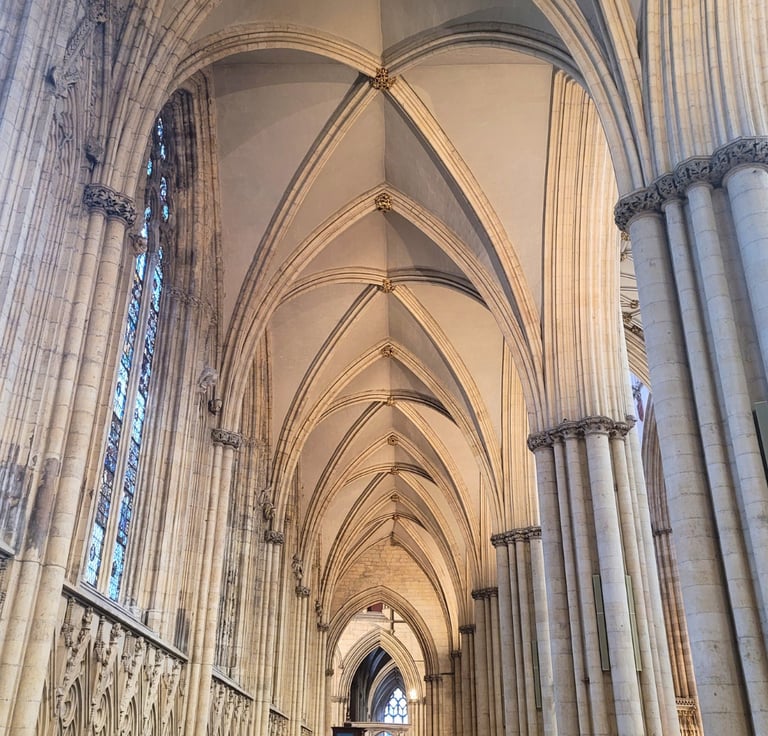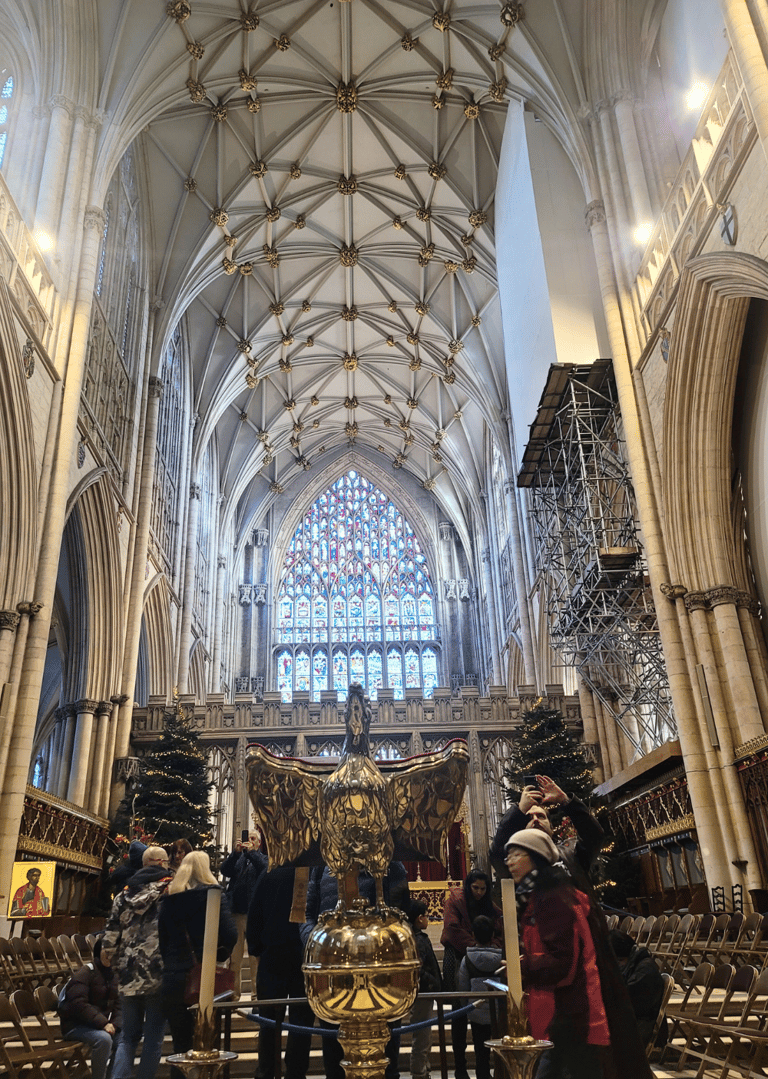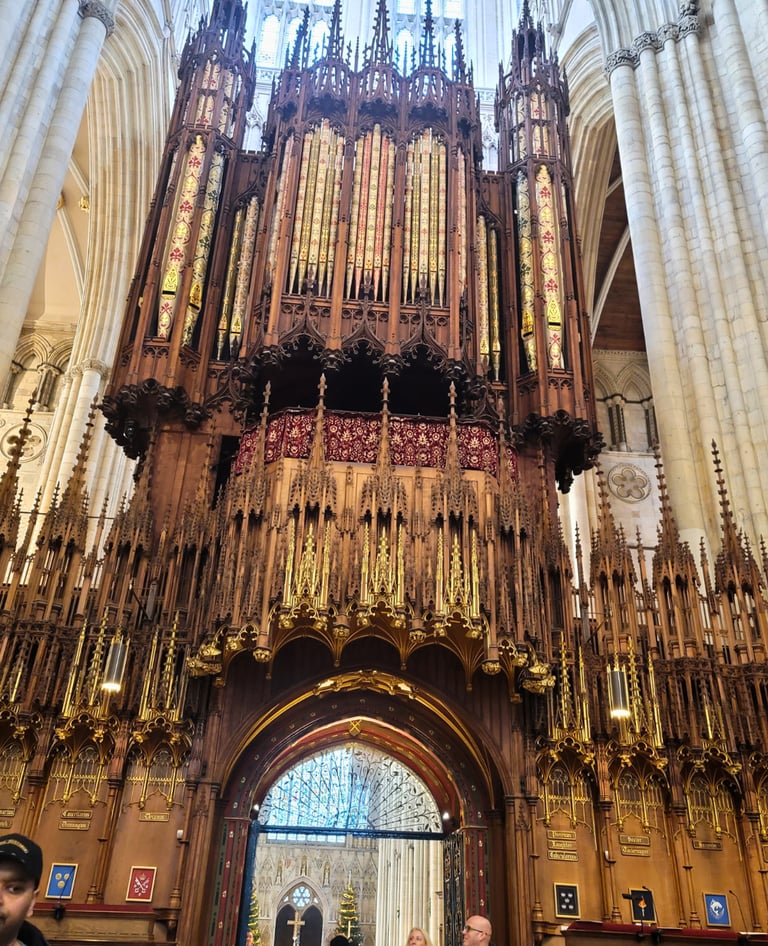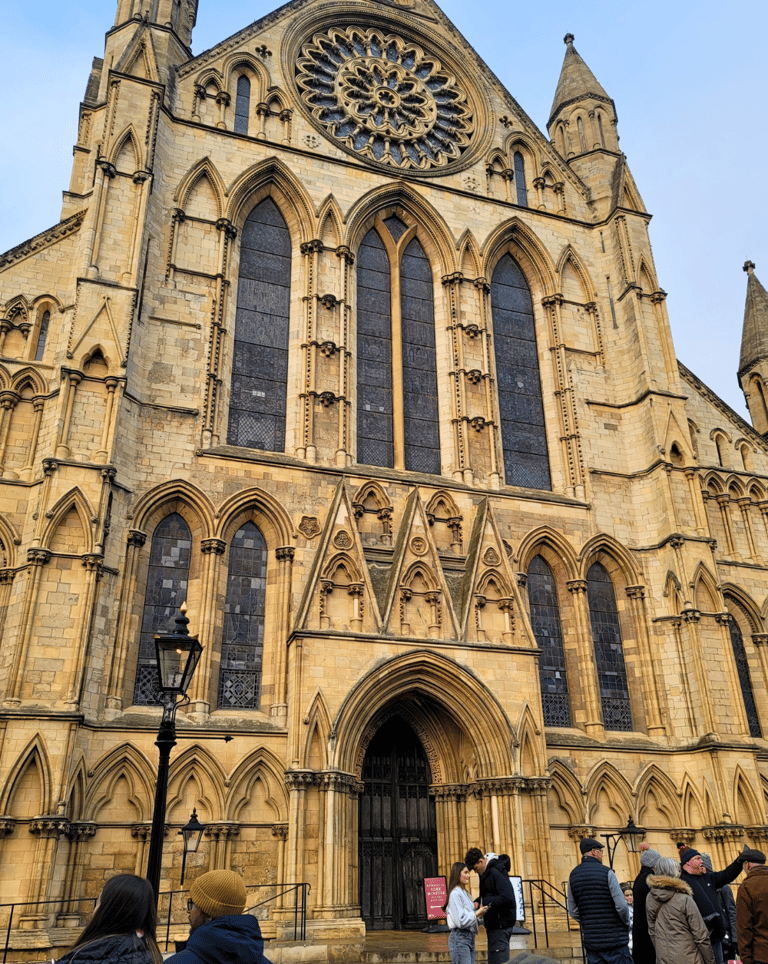York Minster: A Complete Guide to England’s Most Magnificent Cathedral
When you arrive in York, there’s one sight that immediately captures your attention — the soaring towers of York Minster rising above the rooftops. This Gothic masterpiece dominates the skyline and has stood at the heart of the city for centuries. More than just a cathedral, York Minster is a living monument to faith, craftsmanship, and history. Whether you’re an architecture lover, a history buff, or a traveler looking to experience York’s most iconic landmark, York Minster is unmissable. In this guide, I’ll take you through its history, must-see highlights, practical visiting tips, and insider secrets to make your visit unforgettable.
ENGLANDYORKSHIRE
Prabah Gamage
14 min read


A Brief History of York Minster
York Minster’s story spans nearly 2,000 years. The site has been a place of worship since Roman times, when York (then called Eboracum) was an important fortress city. A wooden church was built here in 627 AD for the baptism of King Edwin of Northumbria, marking the start of its Christian significance.
The Minster as we see it today began construction in 1220, with the goal of creating one of the grandest Gothic cathedrals in Europe. It took more than 250 years to complete, with additions continuing into the 15th century. Despite wars, fires, and restorations, it has stood as a symbol of York’s resilience.
Fun fact: York Minster is not just a cathedral — it’s officially known as the Cathedral and Metropolitical Church of St Peter in York. “Minster” is an Anglo-Saxon term for a missionary teaching church.
Late Morning: York Minster
The ancient city walls will eventually lead you to York Minster, the city’s crowning glory and one of the most magnificent Gothic cathedrals in all of Europe. Soaring 72 metres above the cobbled streets, its limestone spires dominate the skyline — a beacon of faith, artistry, and endurance that has watched over York for more than 800 years.
Step inside and you’ll feel time slow down. The hush of the nave, the faint scent of candle wax, and the kaleidoscope of color cast by sunlight through stained glass — it’s an atmosphere that feels both grand and deeply personal. The Great East Window, painstakingly restored over a decade, is the largest expanse of medieval stained glass in the world, illustrating scenes from the beginning and end of time. When the light hits just right, the floor glows in shades of ruby and sapphire — a living work of art created by the morning sun.
Take a moment to look up. The ribbed vaulting arches like an intricate stone forest canopy, each curve a marvel of medieval engineering. The Chapter House, just off the main nave, is another masterpiece — octagonal in design, with detailed carvings that seem to whisper stories from centuries past. Sit on the carved wooden seats and look up at the soaring ceiling — it’s one of the finest examples of English Gothic architecture, yet it somehow feels intimate.
If you’re feeling adventurous, tackle the Central Tower climb — 275 narrow spiral steps that wind ever upward. It’s not for the faint of heart, but the reward is spectacular: panoramic views of York’s terracotta rooftops, winding lanes, and the rolling green fields of Yorkshire stretching into the horizon. From this height, you’ll understand why York Minster has long been a symbol of both spiritual and civic pride.
Before you leave, take a quiet stroll through the Undercroft Museum, located beneath the cathedral. Here you can walk through layers of history — from Roman ruins to Norman foundations — that reveal York’s evolution from Eboracum, the Roman capital of the North, to the vibrant city it is today.
Visitor Info:
🎟️ Tickets: Adult entry around £16; tower climb extra.
🕰️ Hours: Open daily from 9:30 am (times may vary during services).
📷 Photography: Allowed, but please be respectful during worship.
💡 Pro Tip: Visit early or right before lunch to avoid tour crowds, and linger in the Chapter House when it’s quiet — the acoustics are incredible if you softly hum or speak.


Architectural Highlights You Shouldn’t Miss
1. The West Front & Great East Window
Approaching York Minster from the west, you’ll likely pause in awe. The West Front is a masterpiece of medieval ambition — a façade that seems to breathe with life. Its twin towers, rising proudly against the Yorkshire sky, are adorned with delicate pinnacles and lace-like stone tracery that catch the morning light. The craftsmanship is staggering: every carved figure, floral motif, and archway tells a story, each chisel mark a whisper from the 13th century.
Step closer to the great arched doorway and take in the sculpted figures that line the portal — kings, saints, and biblical heroes, all rendered in patient detail by stone masons who worked not for fame, but for faith. Their expressions, softened by time, still carry a sense of reverence and purpose. Look for the Five Sisters Window to the north side too — its slender, gray-green glass panels are a memorial to women who lost their lives in World War I, adding a poignant human layer to the Minster’s history.
Once inside, the Great East Window immediately commands attention. Towering above the choir, it is not only the largest expanse of medieval stained glass in the world — larger than a tennis court — but one of the most extraordinary artistic achievements of the Middle Ages. Completed in 1408 by master glazier John Thornton of Coventry, the window’s 311 individual panels form a vast visual tapestry narrating the story of creation and revelation.
As sunlight filters through its centuries-old glass, the cathedral seems to come alive — angels, prophets, and apocalyptic visions glowing in radiant blues, golds, and crimsons. The upper panels depict scenes from the Book of Revelation, where celestial beings and divine judgment unfold in luminous color; the lower ones tell the story of Genesis, a reminder of beginnings and renewal.
Restored painstakingly over ten years in one of England’s most significant heritage conservation projects, the window is both fragile and eternal — a triumph of faith, artistry, and endurance. Stand quietly for a moment and watch the colored light dance across the stone floor; it’s an experience that transcends time, connecting you to every visitor who has ever stood here in silent wonder.
💡 Did you know?
Each piece of the Great East Window was meticulously removed, cleaned, and repaired during the “York Minster Revealed” project — a £20 million restoration completed in 2018, ensuring its brilliance for future generations.
2. The Nave
Stepping through the great doors into the Nave of York Minster is an experience that can take your breath away. Instantly, you’re enveloped by an immense sense of space — light, air, and silence mingling in a way that feels almost otherworldly.
Look up. The vaulted ceiling, soaring nearly 100 feet high, ripples overhead like the hull of an inverted ship — a symbolic reminder that the church was seen as a vessel guiding souls toward salvation. Each rib of the vault is a masterpiece of medieval geometry, converging in carved bosses that gleam faintly in the filtered light. The clustered columns that rise from the floor give the impression of a forest of stone — strong, graceful, and somehow weightless despite their monumental scale.
Stretching over 150 feet long and spanning one of the widest Gothic naves in Europe, this vast hall was designed to inspire awe. In the 13th century, when most buildings were timber or low stone cottages, entering a space of this magnitude would have been nothing short of a revelation. Even today, it’s hard not to feel small beneath its expanse — a deliberate reminder of divine grandeur.
Yet for all its scale, there’s a remarkable sense of balance and harmony here. The nave’s design — a blend of Early English and Decorated Gothic styles — fills the interior with natural light, creating an atmosphere that’s serene rather than imposing. When sunlight pours through the clerestory windows, it floods the honey-colored stone with warmth, softening the vastness and inviting quiet reflection.
Take a moment to notice the details: the delicately carved capitals on each pillar, the faint grooves worn into the stone floor by centuries of pilgrim footsteps, the subtle acoustics that turn even a whisper into a lingering echo. This space has witnessed royal visits, coronations, funerals, and simple daily prayers — each one layering history into the fabric of the walls.
💡 Pro Tip:
If you visit during an organ recital or choral service, linger for a few minutes in the nave. The sound swells through the arches and fills the space like a living heartbeat — a moment that transforms architecture into pure emotion.


3. The Chapter House
Tucked just off the north transept, the Chapter House is one of York Minster’s most enchanting spaces — a place where art, architecture, and silence come together in perfect harmony. Stepping inside feels like crossing a threshold into another world, one where time slows and whispers of medieval life still seem to linger in the air.
Built in the late 13th century, the Chapter House is an octagonal chamber of breathtaking beauty, designed without a central supporting pillar — a bold architectural innovation for its time. The weight of the soaring timber roof is carried entirely by the surrounding stone walls, a feat that left even contemporary builders in awe. As you stand in the center, look up at the delicate web of beams above you — it’s as if the ceiling floats, defying gravity.
Light streams in through seven tall stained-glass windows, each one a kaleidoscope of color and biblical storytelling. When the sun moves across the sky, the entire room glows in shifting hues of gold, ruby, and sapphire, the reflections dancing across the stone floor and the intricate carvings along the walls.
Those carvings are a masterpiece in themselves — over 200 small figures tucked into the stalls and arches, each one unique. Look closely and you’ll find not just saints and bishops, but faces of ordinary medieval people: musicians, jesters, even a monkey and a man picking his teeth. This touch of humor and humanity gives the space a warmth that contrasts beautifully with its grandeur.
Historically, this was where the Dean and Chapter of York — the cathedral’s governing clergy — gathered daily to discuss church matters and local affairs. The acoustics are so perfect that a speaker in the center could be heard clearly by everyone seated around the perimeter. Today, that same resonance fills the room during choir rehearsals, when angelic voices rise and linger like incense.
Take a seat on one of the carved wooden stalls and simply pause. The hush here feels sacred — a kind of peace that’s rare in the modern world. It’s easy to imagine robed clerics debating theology or medieval masons admiring their own handiwork. Every surface tells a story, every shadow holds a secret.
💡 Pro Tip:
Visit early or late in the day when tour groups have thinned. Sit in silence for a few minutes and listen — the creak of the timber, the soft echo of footsteps, and the faint hum of the wind outside combine into a symphony centuries in the making.


4. The Undercroft & Crypt
Beneath the soaring Gothic splendor of York Minster lies a world entirely different — quieter, darker, and steeped in centuries of history. The Undercroft and Crypt reveal what lies beneath the beauty above: the foundations of faith, architecture, and civilization itself.
Descending the stone steps, the air grows cooler and the light softens, replaced by a warm, museum glow. Here, in the Undercroft Museum, York’s story unfolds layer by layer — quite literally. The Minster isn’t just built on history; it’s built from it.
You’ll walk above the Roman ruins of Eboracum, the ancient military fortress that once stood on this very spot nearly two thousand years ago. Glass walkways allow you to look down on excavated walls, altars, and drainage channels — tangible traces of Rome’s northernmost outpost. Among the most remarkable finds is a Roman column, perfectly preserved, a reminder that this sacred ground has witnessed empire, conquest, and rebirth.
Moving through the museum, the eras shift: from the Roman foundations to Saxon and Viking York, where fragments of early Christian crosses and carved stones speak of a city finding its spiritual identity. Artifacts from Viking Jorvik tell stories of trade, artistry, and faith evolving through invasion and adaptation.
The exhibition then brings you to the medieval treasures of the Minster itself — illuminated manuscripts, ornate chalices, and fragments of stained glass rescued from restoration works. Interactive displays help bring the cathedral’s construction to life, showing how generations of craftsmen, from Norman builders to Victorian restorers, shaped what stands above.
Continue farther down to the Crypt, one of the most atmospheric spaces in the Minster. Dimly lit and echoing with history, this sacred chamber is the resting place of archbishops and nobles who shaped both York and England’s destiny. The scent of stone and candle wax fills the air, and the quiet feels ancient — the kind of silence that hums with memory.
It’s here, more than anywhere else, that you feel the weight of York’s timeline — Roman soldiers, Viking settlers, medieval monks, and modern visitors all layered together in the same sacred ground. Standing among these ruins, you realize York Minster isn’t just a cathedral; it’s a living palimpsest of human history, faith, and endurance.
💡 Pro Tip:
Don’t rush your visit. The museum’s layout rewards curiosity — linger by the Roman wall or pause in the crypt to listen to the faint creak of stone. It’s the kind of place where history doesn’t just inform you — it surrounds you.


5. The Central Tower
For those with energy — and perhaps a touch of courage — the Central Tower climb is one of the most rewarding experiences at York Minster. It’s not just a physical ascent; it’s a journey through the very heart of the cathedral’s architecture, leading you from the sacred quiet below to a view that will quite literally take your breath away.
The climb begins modestly enough, with a narrow spiral staircase of 275 winding steps carved into the ancient stone. The walls close in tightly, cool and slightly damp to the touch, echoing faintly with the footsteps of countless visitors who’ve made the same climb over the centuries. The air smells of history — limestone, candle wax, and the faint tang of age.
As you ascend, small slits of light appear, offering teasing glimpses of rooftops and sky. Periodic landings provide a welcome chance to catch your breath — and to admire the inner structure of the Minster up close. You’ll pass massive medieval timbers and masonry that have held this tower aloft for over 600 years, a humbling reminder of the craftsmanship and faith that built it.
Then, finally, you emerge onto the roof platform — and the reward is nothing short of spectacular. Below you, York unfolds like a storybook map: the tangle of medieval lanes, the red-tiled rooftops, the spires of smaller churches peeking above the skyline. To the north, the rolling hills of the Yorkshire countryside stretch toward the horizon; on a clear day, you can see as far as the North York Moors.
From this height, the Minster’s scale becomes astonishingly clear. You can look down upon its flying buttresses, trace the delicate stonework of its pinnacles, and even glimpse the statues on the West Front from an angle few ever see. The city’s history seems to radiate outward — the Roman walls circling below, the snaking River Ouse, and beyond them, the green quilt of fields and farmland that has sustained York for centuries.
It’s a moment that invites quiet reflection. You’ve climbed through layers of faith, architecture, and time — from Roman foundations to medieval glory to the modern city that hums below. Standing atop the Central Tower, the wind in your hair and the bells occasionally tolling beneath your feet, it’s hard not to feel the pulse of history in every direction.
💡 Pro Tips:
The climb is steep and narrow, so comfortable shoes are a must.
Leave large bags at the base — the staircase is tighter than it looks.
Time your visit for late morning or golden hour, when the light softens over the rooftops and the city glows in warm tones.
Whether you make it all the way to the top or simply watch others ascend, the Central Tower is a reminder that York Minster isn’t just to be admired — it’s to be experienced.
Spiritual & Cultural Importance
York Minster isn’t just a tourist attraction — it’s still a working church. Daily services continue to this day, with choral evensong being a particularly moving experience. Even if you’re not religious, attending a service allows you to hear the acoustics come alive with music.
The Minster also plays an important role in national history. Kings and archbishops have been crowned, buried, and remembered here. Today, it remains the seat of the Archbishop of York, the second-highest position in the Church of England.


Events at York Minster
York Minster isn’t just a place of worship — it’s a living, breathing landmark that continues to inspire creativity, community, and celebration throughout the year. If your visit happens to coincide with one of its special events, you’ll experience the cathedral in an entirely new light — quite literally.
✨ Advent & Christmas
Few places in England capture the spirit of the season like York Minster at Christmastime. As December approaches, the cathedral glows with hundreds of candles and the scent of pine drifts through the air. The Candlelit Carol Services are particularly magical — the flicker of candlelight illuminating the vaulted arches as the choir’s voices rise in harmony. It’s a moment that feels timeless, a bridge between centuries of Christmases past and present. Outside, York’s Christmas market fills the nearby streets with mulled wine, roasted chestnuts, and festive cheer, making this one of the most atmospheric times to visit the city.
🌙 York Minster Nights
On select evenings throughout the year, the Minster transforms after dark for York Minster Nights, an extraordinary experience where history meets modern artistry. The cathedral opens its doors for immersive concerts, candlelit organ performances, or breathtaking light projections that dance across the Gothic stonework. Seeing the Minster illuminated from within — every arch and stained-glass window glowing softly against the night sky — is an unforgettable sight. These events offer a rare chance to see the building in a completely different way: intimate, mysterious, and alive with sound and color.
🎨 Exhibitions & Installations
Throughout the year, temporary exhibitions bring new perspectives to York Minster’s enduring story. Many of these displays focus on the incredible craftsmanship behind its stained glass, sculpture, and restoration projects. You might find interactive exhibits showcasing the tools of medieval stonemasons, fragments of centuries-old glasswork, or even behind-the-scenes looks at ongoing conservation efforts. The Minster’s Stoneyard often participates, offering insight into the artisans who continue to preserve this architectural wonder for future generations.
💡 Pro Tip:
Check the York Minster events calendar before your visit — tickets for concerts and evening openings often sell out early. Even if you can’t attend an event, the cathedral’s daily choral evensong (usually around 5:15 p.m.) is a serene, free way to experience the Minster’s extraordinary acoustics and spiritual beauty.
Practical Travel Guide to York Minster
Location: Deangate, York YO1 7HH, United Kingdom.
Opening Hours:
Generally 9:30 am – 4:30 pm (shorter hours on Sundays).
Services are free to attend, but sightseeing requires a ticket.
Tickets:
Adults: Around £16 (includes entry to the Undercroft Museum).
Tower climb: Additional fee (book early — it sells out).
Children: Free with a paying adult.
Accessibility:
The main cathedral floor is wheelchair accessible.
The tower climb is not accessible due to steep stairs.
Photography:
Allowed for personal use (no flash during services).


Tips for Visiting York Minster
Arrive Early – The cathedral is quieter in the morning.
Join a Guided Tour – Free with admission; guides share fascinating stories.
Attend Evensong – Experience the choir in full voice — it’s unforgettable.
Look for Details – Gargoyles, green men, and tiny carvings hide everywhere.
Buy Tickets Online – Skip the queue and guarantee tower access.
Nearby Attractions
York Minster is in the heart of the city, so you can easily combine it with:
The Shambles – A 5-minute walk to York’s most famous street.
Treasurer’s House – A National Trust property just behind the Minster.
City Walls – Access at Bootham Bar, perfect for a post-visit walk.
Bettys Café Tea Rooms – Treat yourself to tea and cakes just around the corner.
Final Thoughts
Visiting York Minster is more than just sightseeing — it’s stepping into nearly a thousand years of devotion, artistry, and history. Whether you climb the tower, sit quietly in the Chapter House, or simply stand in awe under the stained glass, the experience stays with you long after you’ve left.
If you only have time for one attraction in York, make it York Minster. It embodies the city’s spirit: timeless, inspiring, and utterly unforgettable.
It's Time to Travel Differently
You don’t need to quit your job or become a digital nomad to live more meaningfully. You just need a shift — in mindset, in pace, in how you connect. Let Explore Savor Thrive be your guide to more soulful travel, more memorable meals, and a more intentional life.
Welcome to the journey. We are so glad you're here!

Explore cultures, landscapes, and flavors of life.
© Expore Savor & Thrive 2025 - All Rights Reserved - Photography and Written Content Cannot be Reproduced.
